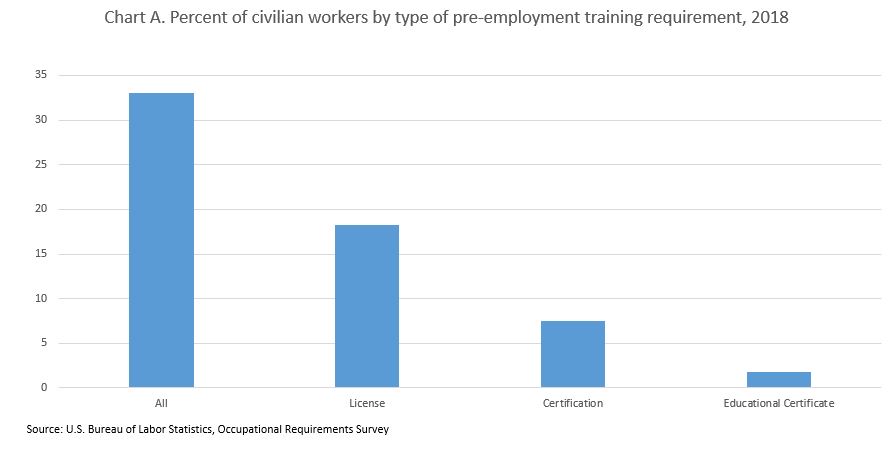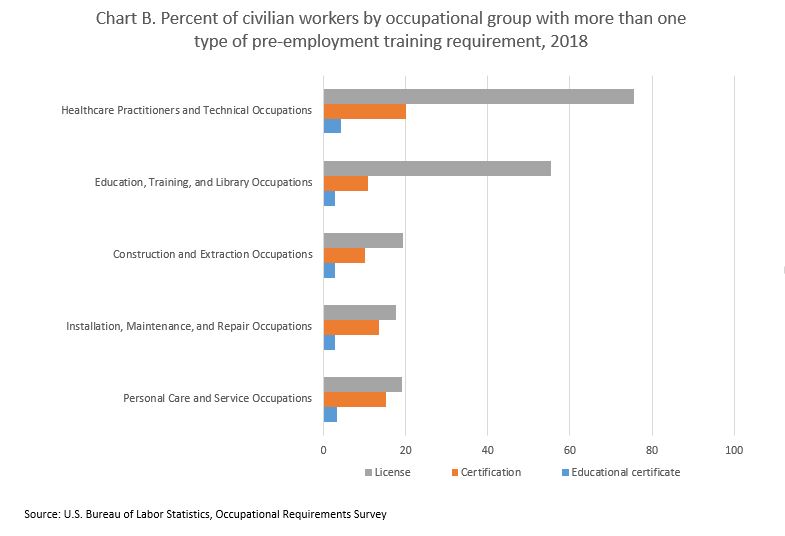An official website of the United States government
 United States Department of Labor
United States Department of Labor
The Occupational Requirements Survey (ORS) provides information about the pre-employment training requirements for workers in the U.S. The job requirements reflect those necessary for workers to perform the critical tasks in support of the critical job functions, and not the capabilities, educational attainment, or experience of the worker. The percentage of workers with pre-employment training requirements and the length of time required to obtain a license, certification, or educational certificate are published.
The overall pre-employment training requirements are estimated using three sample groups collected over a three year period. The type of pre-employment training (license or certification) and duration estimates are calculated with two sample groups collected over a two year period, as survey questions were added to better understand pre-employment job requirements.
At times, the duration of pre-employment training cannot be separated from other preparation requirements (degree requirements, on-the-job training, or work experience). The ORS program captures this concurrent preparation time for pre-employment training as part of one of the other preparation requirements. For example, in some occupations, the duration of pre-employment training is part of the time necessary to attain a specific degree (ex. Bachelor’s degree) and no separate time is captured for pre-employment training. In this situation, pre-employment training is required, but there is no additional time separate from obtaining a degree, so pre-employment training is required but there is no additional time (“yes, no time”).
When there is time required separate from other preparation requirements, the percentage of workers with this type of pre-employment training requirements is published (“yes, with time”) as well as the length of time associated with that pre-employment training requirement.
Pre-employment training includes requirements for certifications, licenses, educational certificates, and other types of pre-employment training.
Apprenticeships, vocational training, non-credit courses, and credit courses that do not result in a degree are included in pre-employment training. Credentials that may be desirable but are not a job requirement, credentials not associated with any critical job tasks and only a hiring criteria requirement, and certificates of attendance or participation for training that is not vocationally relevant are not included in ORS estimates for pre-employment training. Collection procedures are available in the Third Edition of the Collections Manual.
About one-third (33.0 percent) of civilian workers are required to have pre-employment training. The distribution of requirements for workers by type is displayed in Chart A. For some occupations, other credentials make up the majority of pre-employment training. 1

The average number of days and time for each type of pre-employment requirements varies, as shown in Table 1. The number of days in the column on the right reflects the duration of pre-employment training requirements that have associated time.
| Type of pre-employment training | Workers with pre-employment requirement | |||
|---|---|---|---|---|
| Total (in percent) | With no associated time (in percent) | With associated time | ||
| In percent | Duration (in days) | |||
|
Educational Certificate |
1.8 | 0.3 | 1.5 | 231 |
|
License |
18.3 | 12.5 | 5.8 | 215 |
|
Certification |
7.5 | 3.3 | 4.2 | 138 |
|
Source: U.S. Bureau of Labor Statistics, Occupational Requirements Survey |
||||
As previously described, some occupations require pre-employment training time, while other occupations do not require additional time. Table 2. shows the five occupations with the highest percentage of “yes, no time” and “yes, with time” that are published.
| Occupations | Total | With associated time | ||
|---|---|---|---|---|
| Type of pre-employment training | Percent of workers | Yes/No | Percent of workers | |
|
Acute Care Nurses |
License | 99.3 | No | 95.3 |
|
Physical Therapists |
License | 97.2 | No | 92.5 |
|
Lawyers |
License | 97.9 | No | 90.8 |
|
Registered Nurses |
License | 97.2 | No | 85.5 |
|
Critical Care Nurses |
License | 94.2 | No | 85.1 |
|
Lifeguards, Ski Patrol, and Other Recreational Protective Service Workers |
Certification | 73.8 | Yes | 70.5 |
|
Hairdressers, Hairstylists, and Cosmetologists |
License | 100.0 | Yes | 69.1 |
|
Insurance Sales Agents |
License | 89.4 | Yes | 60.5 |
|
Emergency Medical Technicians and Paramedics |
License | 89.1 | Yes | 49.6 |
|
Sheriffs and Deputy Sheriffs |
License | 67.1 | Yes | 49.5 |
|
Note: Not all published pre-employment training requirement estimates are displayed, see www.bls.gov/ors for additional series. |
||||
Although pre-employment training is required for less than half of all civilian workers, it is more commonly required for certain occupations. Table 3. provides examples of detailed occupations with pre-employment requirements by type.
| Occupation | Type of pre-employment requirement | Percent of workers |
|---|---|---|
|
Hairdressers, Hairstylists, and Cosmetologists |
License | 100.0 |
|
Lawyers |
License | 97.9 |
|
Emergency Medical Technicians and Paramedics |
License | 89.1 |
|
Lifeguards, Ski Patrol, and Other Recreational Protective Service Workers |
Certification | 73.8 |
|
Surgical Technologists |
Certification | 66.0 |
|
Plumbers |
License | 58.3 |
|
Nursing Assistants |
Educational certificate | 36.1 |
|
Note: Some of the occupations in Table 3. require multiple types of pre-employment training in addition to the requirement type listed. |
||
Within occupations, there can be multiple types of pre-employment training required. Licenses tend to be the most common requirement for pre-employment training for the select major occupations featured in Chart B, similar to the distribution for all civilian workers.

| Type of pre-employment training requirement | Personal Care and Service Occupations | Installation, Maintenance, and Repair Occupations | Construction and Extraction Occupations | Education, Training, and Library Occupations | Healthcare Practitioners and Technical Occupations |
|---|---|---|---|---|---|
|
Educational certificate |
3.3 | 2.9 | 2.7 | 2.7 | 4.2 |
|
Certification |
15.2 | 17.6 | 10.0 | 10.9 | 20.2 |
|
License |
19.2 | 13.6 | 19.3 | 55.4 | 75.5 |
1 In addition to providing information on pre-employment training required for workers, pre-employment training is also used to calculate Specific Vocational Preparation (SVP). SVP is the total preparation time necessary from pre-employment training, degree requirements, prior work experience and on-the-job requirements to perform the critical tasks in support of the critical job functions, and is published as a percent of workers in each level of SVP. SVP is published as levels between 1 and 9, and reflect preparation time necessary (short demonstration lasting 4 hours or less to over 10 years, respectively). Additional information on preparation requirements is available in the minimum education requirements fact sheet and the Calculation section of the Handbook of Methods.
Last Modified Date: April 02, 2020